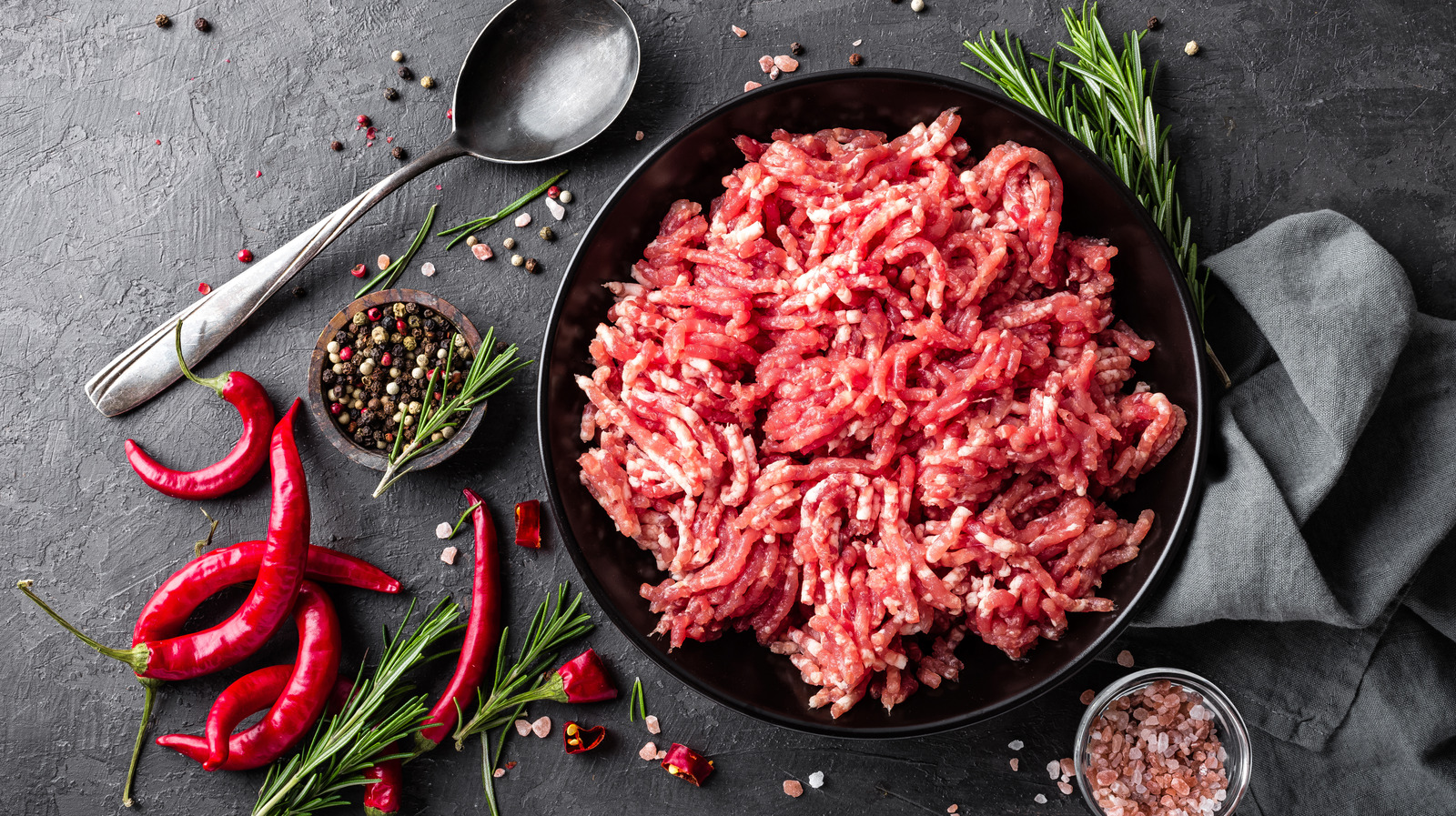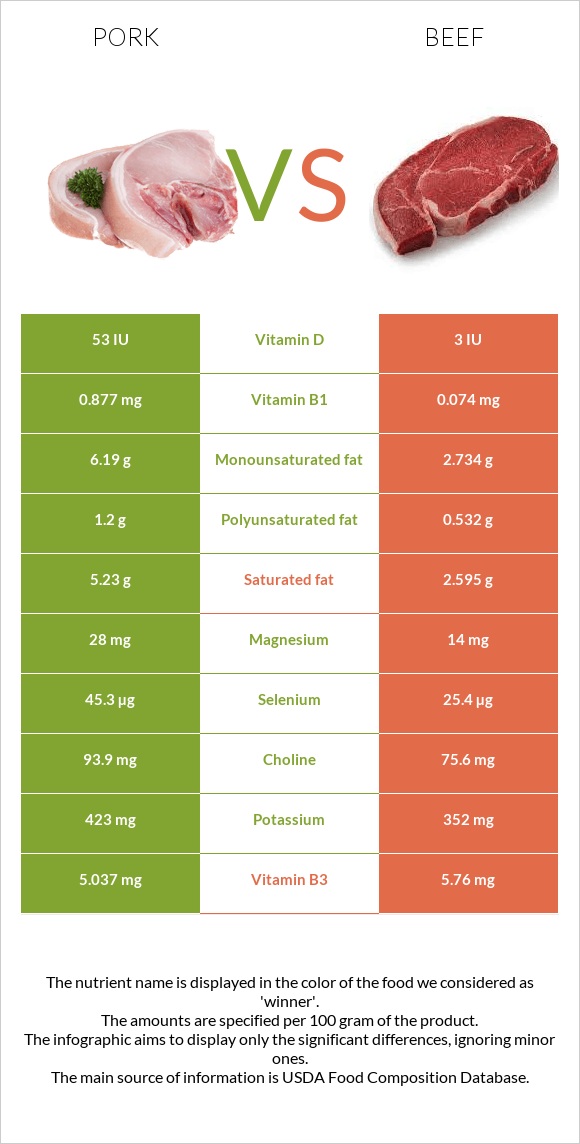Nutritional Comparison Between Ground Beef And Ground Pork

Ground beef and ground pork offer different nutritional profiles, giving consumers options based on their dietary needs. Ground beef is typically higher in calories and fat compared to ground pork. However, it also provides more protein and essential vitamins like B12 and zinc. On the other hand, ground pork is lower in calories and fat, making it a leaner option. It contains slightly less protein but offers higher levels of selenium, thiamin, and vitamin B6. Both meats can be a part of a balanced diet, but it’s crucial to choose lean cuts and moderate portion sizes to maintain optimal health.
1 Key Differences In Calories And Fat Content
When it comes to comparing ground beef and ground pork, one key difference lies in their calorie and fat content. Ground beef tends to have slightly higher calories and fat compared to ground pork. While a 100-gram serving of ground pork contains about 263 calories and 21.2 grams of fat, ground beef can vary depending on its lean and fat content. Typically, leaner varieties of ground beef will have lower calorie and fat content, while fattier cuts will have higher levels. It’s important to consider these differences when choosing between the two meats for your dietary needs.
2 Protein And Vitamin Content In Ground Beef Vs. Ground Pork
When comparing the protein and vitamin content of ground beef and ground pork, there are a few notable differences to consider. While both meats provide a good source of protein, ground beef tends to have slightly higher protein content compared to ground pork. Protein is essential for muscle growth and repair, making it an important nutrient for active individuals. Additionally, ground beef is also richer in vitamins B12 and B6 compared to pork. These vitamins play a key role in maintaining a healthy nervous system and aiding in the production of red blood cells. Incorporating both ground beef and ground pork into your diet can help ensure a balance of essential nutrients.
Cooking And Flavor Profiles Of Ground Beef And Ground Pork

Ground beef and ground pork offer distinct flavor profiles that can enhance a wide range of dishes. Ground beef is renowned for its rich and savory taste, adding a deep umami flavor to recipes. This makes it a popular choice for classic dishes such as hamburgers, meatloaf, and chili. On the other hand, ground pork has a sweeter and milder taste, making it a versatile ingredient in dishes like meatballs, sausage, and stir-fries. Both meats can be seasoned and cooked in various ways to complement different cuisines and personal preferences. Whether you prefer the robustness of beef or the subtle sweetness of pork, these proteins offer endless culinary possibilities.
1 Tips For Cooking Ground Beef For Optimal Flavor
To achieve optimal flavor when cooking ground beef, there are a few key tips to keep in mind. First, choose the right type of ground beef for your recipe. Different cuts of beef have varying levels of fat content, which affects flavor. For burgers, opt for ground beef with a higher fat content, such as 80/20 or 85/15, as the added fat enhances juiciness and flavor. Secondly, avoid overcrowding the pan when cooking ground beef. This allows the meat to brown evenly and develop rich, caramelized flavors. Lastly, season the beef generously with spices, herbs, and seasonings to enhance its natural flavor profile. By following these tips, you can ensure that your ground beef dishes are bursting with delicious flavor.
2 Enhancing The Taste Of Dishes With Ground Pork
When it comes to enhancing the taste of dishes with ground pork, there are a few key techniques to keep in mind. First, consider incorporating a variety of spices and herbs to add depth and complexity to your recipes. Ground pork pairs particularly well with flavors like garlic, ginger, chili flakes, and Chinese five-spice powder. Secondly, combining ground pork with other ingredients such as vegetables, sauces, and aromatics can help create a harmonious flavor profile. Lastly, don’t underestimate the power of proper seasoning. Don’t be afraid to generously season your ground pork dishes with salt, pepper, and other seasonings to enhance the overall taste. Whether you’re making meatballs, dumplings, or stir-fries, these tips will help take your ground pork dishes to a new level of deliciousness.
Health Considerations: Ground Beef Vs. Ground Pork

When it comes to health considerations, there are a few factors to keep in mind when choosing between ground beef and ground pork. One of the main differences lies in their fat content. Ground pork tends to have a higher fat content compared to ground beef, which can contribute to higher calorie and cholesterol levels. On the other hand, ground beef is often leaner and can provide a good source of protein and essential nutrients. It’s important to consider your individual health needs and dietary restrictions when deciding between these two meats.
1 Impact On Cholesterol Levels And Heart Health
Ground beef and ground pork can have differing impacts on cholesterol levels and heart health. Ground pork tends to have a higher fat content, including saturated fat, which can raise cholesterol levels and increase the risk of heart disease. On the other hand, ground beef, especially lean cuts, can provide a good source of protein while minimizing saturated fat content. Choosing lean ground beef over higher fat ground pork can be a healthier option for maintaining cholesterol levels and promoting heart health. It’s important to consult with a healthcare professional to determine the best choice for your individual needs.
2 Dietary Restrictions And Allergies Related To Beef And Pork
Dietary restrictions and allergies related to beef and pork are important considerations when deciding between the two meats. Some individuals may choose to avoid beef or pork due to religious or cultural reasons. Additionally, there are people who have specific dietary restrictions, such as those following a vegetarian or vegan diet, who would not consume either meat. Allergies to beef or pork are rare but can occur. It is essential for individuals with allergies to avoid consumption of these meats and seek alternative protein sources that meet their dietary needs.
Environment And Sustainability Factors

When it comes to choosing between ground beef and ground pork, it is important to consider the environmental and sustainability factors associated with each meat. The beef industry has a higher carbon footprint and requires more water usage compared to pork production. This is primarily due to the fact that cattle require more feed to reach market weight, leading to increased greenhouse gas emissions. On the other hand, pork production is generally more resource-efficient and has a lower environmental impact. By choosing lean cuts of pork or beef and supporting sustainable farming practices, individuals can contribute to reducing the environmental impact of meat consumption.
1 Carbon Footprint And Water Usage In Beef And Pork Industry
The carbon footprint and water usage in the beef and pork industry are important factors to consider when comparing the environmental impact of these meats. Beef production has a higher carbon footprint compared to pork production, emitting 11 times more greenhouse gases. Additionally, beef production requires approximately 20 times more land and has higher water consumption. On the other hand, pork production is generally more resource-efficient and has a lower environmental impact. By choosing lean cuts of pork and supporting sustainable farming practices, individuals can contribute to reducing the carbon footprint and water usage associated with meat production.
2 Sustainable Farming Practices For Ground Beef And Pork Production
Sustainable farming practices play a crucial role in reducing the environmental impact of ground beef and pork production. Two key practices that promote sustainability are regenerative agriculture and rotational grazing. Regenerative agriculture focuses on building healthy soil through practices like cover cropping, crop rotation, and reduced tillage. This not only improves the quality of the land but also sequesters carbon, mitigating climate change. Rotational grazing involves moving animals to different sections of pasture, allowing the land to rest and recover. This prevents overgrazing and promotes biodiversity. Supporting farms that prioritize these sustainable practices can help minimize the ecological footprint of ground beef and pork production.
Culinary Versatility: Recipes And Dishes With Ground Beef And Ground Pork

Ground beef and ground pork offer incredible culinary versatility, adding flavor and texture to a wide range of dishes. Ground beef is commonly used in classics like hamburgers, meatballs, and tacos, while ground pork shines in dishes like pork dumplings, meatloaf, and stir-fries. For a fusion twist, try incorporating ground beef into Asian-style lettuce wraps or using ground pork to make a hearty Bolognese sauce. Both proteins can be seasoned with a variety of herbs and spices to suit different cuisines and preferences. So whether you’re craving comfort food or exploring new flavors, the possibilities with ground beef and ground pork are endless.
1 Popular Dishes Using Ground Beef
One can find a multitude of popular dishes that showcase the versatility of ground beef. From the classic American favorite, the hamburger, to the comforting Italian dish of spaghetti Bolognese, ground beef takes center stage in many beloved recipes. Other dishes include meatballs, tacos, chili, and shepherd’s pie. With its rich flavor and ability to absorb a variety of seasonings, ground beef lends itself well to a wide range of culinary creations. Whether you’re craving a juicy burger or a hearty pasta dish, ground beef is sure to satisfy your taste buds.
2 Creative Ways To Incorporate Ground Pork In Cooking
When it comes to incorporating ground pork into your cooking, there are endless creative possibilities. Here are two unique and delicious ways to use this versatile protein:
- Asian-inspired Dumplings: Ground pork is a key ingredient in many Asian dumpling recipes. Mix the ground pork with flavorful spices, such as garlic, ginger, and soy sauce, and wrap the mixture in dumpling wrappers. Steam, fry, or boil the dumplings until cooked through. Serve them as a delightful appetizer or a main course. The succulent and juicy filling of the dumplings pairs perfectly with dipping sauces like soy sauce or chili oil.
- Stuffed Bell Peppers: Give your stuffed bell pepper recipe a twist by using ground pork instead of the traditional ground beef. Brown the ground pork with onions, garlic, and your favorite seasonings. Then, stuff the mixture into hollowed-out bell peppers and bake them until tender. The ground pork adds a rich and savory flavor to the dish, complemented by the sweetness of the roasted bell peppers. Top them with cheese for an extra indulgence.
These creative ways to incorporate ground pork will bring new flavors to your cooking repertoire. Whether you’re craving Asian flavors or looking to switch up your stuffed pepper recipe, ground pork is a delicious choice that will elevate your culinary creations. Keep experimenting and enjoy the delightful results!
Conclusion

In conclusion, the debate between ground beef and ground pork ultimately boils down to personal preference and dietary considerations. While ground beef may have a slight advantage in terms of fitness and nutritional content, it’s important to remember that individual needs and tastes differ. Both beef and pork can be enjoyed as part of a well-balanced diet, as long as lean cuts are chosen and portion sizes are moderated. Ultimately, the key to a healthy diet lies in incorporating a variety of nutritious foods and enjoying them in moderation. Whether you prefer beef or pork, make sure to prioritize balance and enjoyment in your meals.
1 Summary Of Key Points In The Ground Beef Vs. Ground Pork Debate
The debate between ground beef and ground pork ultimately comes down to personal preference and dietary considerations. Ground beef is lower in calories and fat content, making it a suitable choice for those seeking a lean protein source. On the other hand, ground pork offers a distinct flavor and tenderness that can enhance the taste of various dishes. Both meats provide essential nutrients like protein and vitamins, but it’s essential to consider individual health needs and dietary restrictions. Whether you choose ground beef or ground pork, incorporating a variety of nutritious foods into your diet is key.
2 Personal Preferences And Considerations When Choosing Between The Two Meat Options
When it comes to choosing between ground beef and ground pork, personal preferences and dietary considerations play a significant role. Some individuals may prefer the rich, savory flavor of ground beef, while others may enjoy the slightly sweeter and milder taste of ground pork. Texture and tenderness are also factors to consider, as ground beef tends to be leaner and denser, while ground pork offers a softer and more delicate texture. Additionally, dietary restrictions, such as allergies or health conditions, may influence the decision between these two meats. Ultimately, it is important to consider individual tastes and needs when choosing between ground beef and ground pork.
FAQ About Ground Beef Vs Ground Pork: The Great Meat Debate
Q: What are the main differences between ground beef and ground pork?
A: Ground beef comes from beef, while ground pork is derived from pork. They differ in taste, texture, and fat content.
Q: Which one is healthier, ground beef or ground pork?
A: Ground beef is generally leaner than ground pork, making it a healthier option for those watching their fat intake.
Q: Can ground beef and ground pork be used interchangeably in recipes?
A: Yes, they can be used interchangeably in many recipes, but keep in mind that they have different flavors that may affect the overall taste.
Q: How should ground beef and ground pork be stored?
A: Both ground beef and ground pork should be stored in the refrigerator at or below 40°F (4°C) and used within 1-2 days of purchase.
Q: Are there any safety concerns specific to either ground beef or ground pork?
A: Ground beef is more prone to contamination with E. coli bacteria, while ground pork may carry parasites like Trichinella. Proper cooking is essential to kill any harmful bacteria or parasites.
Q: What are some popular dishes that feature ground beef or ground pork?
A: Ground beef is commonly used in dishes like burgers, meatballs, and chili, while ground pork is often used in recipes such as meatloaf, sausages, and dumplings.
Q: Can ground beef and ground pork be mixed together in recipes?
A: Yes, combining ground beef and ground pork can create a unique flavor profile that enhances certain dishes like meatloaf or bolognese sauce.

The Stone’s Sports Grill and Bar was Established on December 1, 2021. The Stone is a Sequel to another restaurant called Cornerstone’s First Edition in Tucumcari, NM. This particular venue is located on the Southeast side of Colorado Springs. The Stone is Wide Open. We have a large dance floor, multi-level stage, pool room, (5) dart boards, and a bar with a large selection of wine spirits and brews.